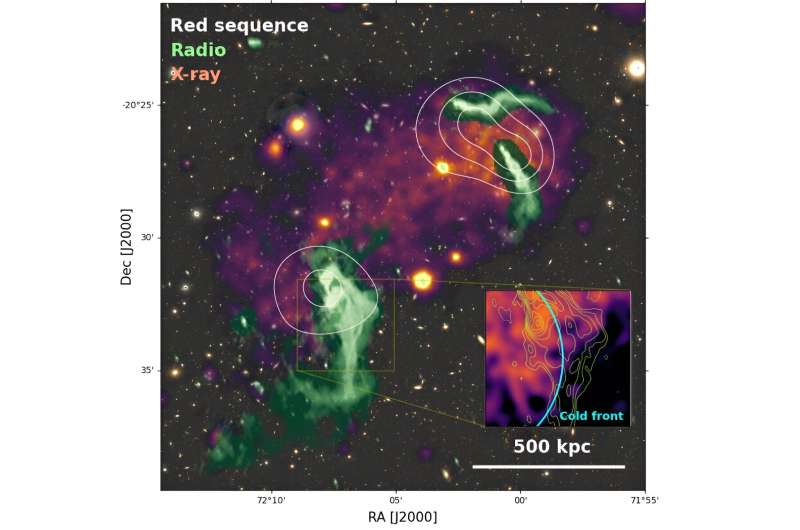October 9, 2023 report
This article has been reviewed according to Science X's editorial process and policies. Editors have highlighted the following attributes while ensuring the content's credibility:
fact-checked
preprint
trusted source
proofread
Large-scale bent radio jet detected in galaxy cluster Abell 514

Astronomers have conducted deep low-frequency radio observations of the galaxy cluster Abell 514, using the upgraded Giant Metrewave Radio Telescope (uGMRT). In their results, they detected a large-scale bent radio jet in this cluster. The finding is reported in a paper published October 2 on the pre-print server arXiv.
Galaxy clusters are the largest gravitationally bound structures, consisting of up to thousands of galaxies bound together by gravity. They could be crucial in improving the knowledge about large-scale structure formation and evolution of the universe.
Abell 514 (or A514 for short) is a merging galaxy cluster at a redshift of approximately 0.07, discovered in 1958. It has a mass of about 300 trillion solar masses, overall temperature of 3.8 keV, and its metallicity is estimated to be at a level of 0.22. Previous observations of A514 have found that it has a rich morphology and hosts several extended radio sources.
Recently, a team of astronomers led by Wonki Lee of the Yonsei University in Seoul, South Korea, decided to investigate the radio sources in A514 by performing radio observations of this cluster with uGMRT.
"We observed A514 using uGMRT Band 2 (125−250 MHz), Band 3 (250−500 MHz), and Band 4 (550−850 MHz) with on-source integration times of 3.5, 3.7, and 4.3 hours, respectively," the researchers explained.
The observations found that radio emissions from one of three radio galaxies in A514, designated PKS 0446-20, originates from the two radio lobes of the active galactic nucleus (AGN) and extends toward the southern periphery. The largest linear size of this bent jet was measured to be about 2.3 million light years.
The images obtained with uGMRT show that two radio lobes are connected to the 1,300-light-years-long north-south structure that was dubbed "the bridge." The southern end of the bridge connects with the 1,000-light-years-long "arc," which is concave toward the cluster center. The eastern end of the arc appears to touch the northern end of the 1,300-light-years-long tail.
The observations also detected a discontinuity in X-ray surface brightness and high polarization at the location of the extended radio emission in A514. This, according to the authors of the paper, is a result of the jet plasma redistribution along the cold front of the recent cluster merger.
The researchers explained that a passive plasma bubble, injected during an off-axis cluster merger, can undergo stretching along the cold front of the infalling cluster.
"This stretching process results in an extended radio emission that resembles the observation in A514. At the late merger phase, the bubble redistributes at the cluster outskirt with its elongation aligned tangential to the cluster," the scientists concluded.
More information: Wonki Lee et al, Discovery of a large-scale bent radio jet in the merging cluster Abell 514, arXiv (2023). DOI: 10.48550/arxiv.2310.00914
Journal information: arXiv
© 2023 Science X Network





















